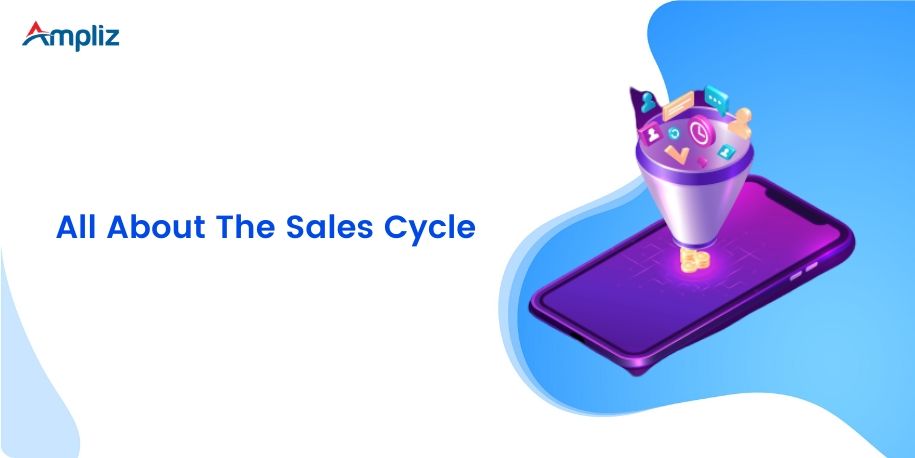If you are a salesperson, there are good chances that you must be battling a lot of questions in your mind each day. It could simply be – what is stopping you from achieving your targets? Why you are facing certain roadblocks? Why you are not able to drive the revenue you deserve? Why you are not able to build sustainable relationships with clients for better success and outreach? But, don’t worry.
You are not alone as many salespersons battle this dilemma constantly. Fret not; help is at hand as we guide you through the sales cycle process and its intricacies. In this guide, we will cover everything you want to know about a sales cycle and offer tips you can use to improve your sales process. Let us start with the basics first.
What is a sales cycle?
A sales cycle is simply a group of actions that sales reps follow in a particular order to convert leads into customers. The process starts with prospecting and ends at closing the deal. In many cases, it can also beyond closing to the referral stage where salespersons ask for referrals from clients. A sales cycle can vary a lot depending on the businesses and their scale of operations. However, in most cases, a similar sequence of steps is followed.
Why do you need a sales cycle?
It is very important for you to come up with a sales cycle process if you haven’t been successful in recent times. You must identify various stages of your sales cycle and identify some key metrics that can be used to measure the effectiveness of your team’s approach.
A well-defined sales cycle makes it easier for your sales reps – whether experienced or even newbies who are up for training. The benefits of having structured and defined objectives are numerous and they can’t be stressed upon enough. It also gives your sales reps a better understanding of your sales cycle for the effective functioning of the sales process.
Once you start creating a sales cycle, you might definitely come across areas that need improvement. There can’t be a better way of ironing out your flaws before you go out all guns blazing to achieve your targets. Also, keeping a track of your sales cycle ensures that your team is aligned with the targets. A shorter sales cycle means that your sales reps are doing a good job by managing to close the leads in the shortest time.
The 7 different stages of a sales cycle
Different sales teams have different sales cycles depending on the approach they follow. However, there are certain stages that are quite common for most companies. Let us have an in-depth look at each of them.
1. Prospecting
In order to sell your product, you must identify the right audience that would be interested in your product and most probably make a sale. This happens at the very first stage, which is prospecting. There are a number of ways to generate leads which include – cold emails, cold calls, lead databases, inbound marketing, SEO, and other lead generation techniques.
However, at this stage, it might be difficult to understand which prospects would most likely get converted. The one you are absolutely sure will get converted must be separated and the rest that is dicy can be put in a different group.
While it is true that prospecting as a function can be attributed to the marketing team, on many occasions, junior members of the sales team are assigned the task as well. This means that it could be a combined sales and marketing cycle.
2. Preparing
At this stage, you must do your homework and identify what is that really excites your prospects. With the right personalization and targeting, you can close the deals much quickly. There are numerous ways to learn about your prospects, starting with their social media feeds.
It would be a bonus if you find things that are in common between you which could probably act as an icebreaker once you connect. Besides knowing their personality, you must also make that effort to understand their professional life and other intricate details about their company and its products and services. If you realize that they are not someone very high in the hierarchy, you can rethink and try to target someone with whom the decision-making process would be a lot quicker.
It becomes important for salespersons to target someone who is up in the hierarchy, especially if it is a heavy-weight deal. This also necessitates heavy-duty research as it might take a lot to convince someone who is up in the hierarchy. However, it is advisable to remain genuine and not go overboard in researching the prospect. You might end up offending them if you reveal something that is unwelcome.
3. Approaching
This is still an early stage in a sales cycle process where sales reps try to set up meetings after zeroing in on prospects. The ease or difficulty with which you manage to secure that all-important meeting can say a lot about the future of your business relationship. Again, it can get a lot difficult if you need to set up a meeting with someone very senior.
They might not readily spare time for you and you might require exchanging a number of pleasantries before you sit down to talk business. Give a pat on your back when you finally manage to set up a meeting. Remember, you are one more step closer to making the sale.
4. Presenting
It’s your time to shine and you must make the best use of this opportunity. Depending on the type of product you are selling, you must make an appropriate presentation. You might give a brief overview of your product and how it will help clients or you might show a demo of your product.
You must understand the priorities, the precise wants of your clients, and their action plans. Based on those answers, you must try to fit in and convince them of how your products will be the best solution they are seeking. You can also offer your insights and recommendations to make it more personal and show how much you value the deal.
5. Overcoming objections
Questions and objections during the pitching stage are very common but the key here is to not lose hope. You must be mature enough to not take anything personally and tackle each question and objection objectively. Stats have proved that as many as 44% salespeople do not proceed after the first rejection. Follow-ups have a lot of power and in four out of five cases, it might take at least five attempts to close the deal. A good salesperson is someone who will remain undeterred and handle all the concerns at ease to close the deal.
The experienced members of your team might know certain kinds of objections that come repeatedly. These can be documented well to train your junior members who can handle them at ease in the future. Further, you must also try to understand the pain points of your customers and understand why their previous strategy did not work.
You must make them understand why it did not work previously and how you can help them overcome that. Your assurances can’t get better if you back them up with an action plan with fixed timelines. Remember, there is a difference between people who only talk and the ones who talk and act immediately. You would surely want to fall into the second category.
6. Closing
You must congratulate yourself once you successfully manage to convince the client and overcome their objections. The next step is closing that elusive deal. If you are thinking that the difficult days are over and the client would simply sign the deal, think again. However, you must remain prepared for the worst.
This is not to scare you but to keep you warned. It might happen that there is a delay in the approval process at the client’s end or even a few negotiations when it comes to pricing or delivery terms, etc. This requires a lot of patience and positivity to remain calms and overcome any final glitches.
7. Following up
The job of a salesperson just doesn’t finish at making the sale. The final stage is follow-up which is the time to gel with the client. There are two positive aspects of developing a good business relationship with the client – securing repeat business and getting referrals. You already know how crucial it is to retain customers and have recurring business with them.
Acquiring new customers means going through the same cycle over and over again which is very resource-intensive. So it becomes crucial to nurture your existing clients with the best value-added proposition. However, you must understand the limitations and must not go to the extent of overdoing it. To remain on the safer side, you can get into an agreement to set up follow-up meetings regarding the progress.
You must also remember that a good follow-up process can also lead to referrals. A satisfied client will definitely recommend your products or services to their peers. It is the easiest way to land customers without putting in any resources. There can’t be a better time to ask for referrals during the follow-up stage. Remember, you must not rush with it and probably let the client get a little more comfortable with you. A happy and smiling is most likely to recommend your service than the ones who still haven’t developed that comfort or trust with you.
After developing an understanding of the seven stages of the sales cycle it is time to understand the duration of sales cycles and what they mean.
Varied Durations of a sales cycle
A sales cycle can take a fixed time to complete but it can be long or short depending on the type of your product and approach you to adopt. The cycle begins with the prospecting stage and ends at making the sale and doing the follow-up.
With time being a premium commodity in sales, it is advisable to expedite the sales cycle process. However, it should not come at the cost of building better business relationships with the clients. Let us understand what are long cycles and short cycles in detail.
Long sales cycle
The duration of a sales cycle can vary according to the type of product or service that is being sold. When it comes to buying a commodity of daily use, the customer won’t think much and make the sale immediately. However, when it comes to B2B sales, the process could take months or even years. B2B sales are the toughest and involve a lot of convincing, decision-making, approvals all of which makes it a lengthier process.
If we consider the brighter side of it, you must rejoice as the longer the sales cycle, the more chance you get to interact with the client and build a strong relationship. A good relationship with the client automatically leads to long-term and recurring projects. The time investment here proves valuable as you can gain a significant trust of your client. It could also help you earn valuable referrals.
Short sales cycle
Even in short sales cycles, the duration could vary depending on the product or service being sold. When it involves selling products that will be used for a long time like electronics items, it again becomes important to keep the cycle short. This should not come at the cost of building a relationship with the client. Shorter cycles are especially beneficial for salespersons who have bigger targets with lesser product value.
With a shorter sales cycle, you can spend more time in prospecting other leads who could convert. Instead of spending 10 days on a particular client, if you wrap it up in five days, you can meet many other prospects to close more deals. When you meet more people, more avenues open. Even if you don’t manage to close the deal, you can store their information to approach them later.
Here’s why you should create and maintain a sales cycle
You might be surprised to know that you already have a sales cycle even if it’s not documented. However, that is not the right approach as you need a well-structured and documented sales cycle. It could happen that your sales reps already follow a traditional approach but it can be problematic when it comes to a team.
Your entire sales team must be on the same page to maintain consistency in approach. It also helps to nurture the younger lot that needs to be groomed for the future. Here is what you can achieve through a well-structured and documented sales cycle.
- Clarity
The senior members of your sales team can monitor the performance of your sales reps and identify gaps for upskilling.
- Consistency
This will ensure that your sales reps work on a strategized and pre-defined approach to make the sales quickly.
- Transition
If the need arises to change your sales reps, it can happen in a seamless way when your new reps know what they need to do in a precise manner.
- Experience
Based on your past successful attempts, your sales reps can know what exactly works to close deals.
- Precedence
Your sales reps will know which client needs prioritization based on past performance.
- Forecasting
It becomes much easier for sales reps to predict the outcomes when they know how much effort is required at each stage.
- Improved sales and ROI
When you begin experiencing success due to all of the above factors, it would automatically boost your sales and bring a better ROI.
How is a sales cycle calculated?
As already seen above, a sales cycle involves several stages before prospects turn into clients. You need to successfully clear each stage of the funnel to keep the sales cycle short. However, based on certain trends, you can figure out the duration of a sales cycle. You can start by researching and analyzing the past successful sales attempts.
This would primarily involve the time gap between gaining the lead and closing the sale. You can further calculate and deduce the average number of days required by you to turn the prospects into clients.
The effect of a sales cycle’s duration on marketing and outreach?
You can plan your advertising campaign and other outreach programs once you understand the length of your sales cycle. You can allocate fixed budget advertising and anticipate a realistic ROI. It will further help in forecasting and planning a further line of action to promote your product or service to prospects.
You can also iron out flaws and determine certain areas that need to be fixed. If you have a longer sales cycle, it could mean that you might need more investment and ROI could get affected proportionately. This could help by setting realistic expectations and forecast sales in a better way. All of this leads to better efficiency and optimum resource utilization.
Final thoughts
So this was all about the sales cycle, its stages, and durations. It is quite a comprehensive guide and might look overwhelming. If you do not have a sales cycle, you can get one created today by following these tips. Remember, there is no shortcut to making a successful sale.
So to make your sales process more effective, take it one step at a time. It needs a sustainable approach and having a sales cycle could be the first step in that direction. Even if you have a sales cycle in place, you can always look for improvements. After all, everyone loves to close deals and generate more business.




